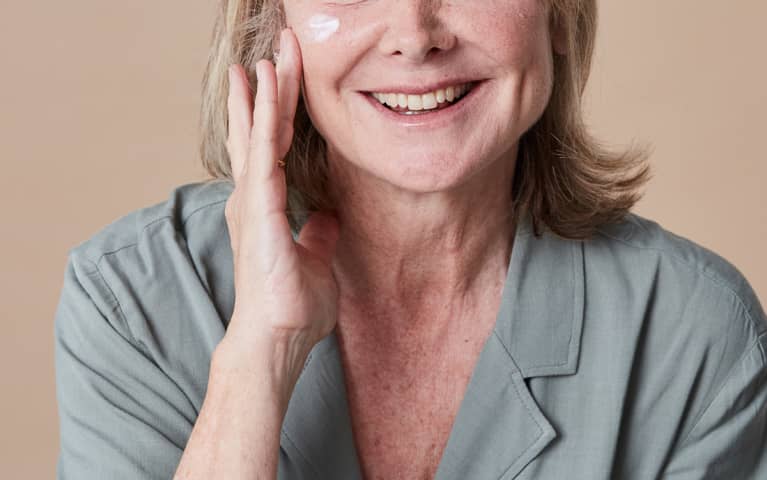How to Get Rid of Crepey Skin on Upper Arms
Crepey Skin: Causes, Prevention & How To Treat Paper-Thin Skin

Our editors have independently chosen the products listed on this page. If you purchase something mentioned in this article, we may earn a small commission.
Imagine a sheet of crepe paper—that thin, wispy material commonly used to make streamers or fold into faux flowers. Sure, it's great for all your DIY craft projects, but it's not so fun when your skin resembles the same fragile texture. But crepeyness isn't as inevitable as you may think; here's everything you need to know about what causes crepey skin, plus how to prevent it and enjoy firm-looking skin for as long as possible.
What is crepey skin?
When your skin thins over time due to a lack of collagen and elastin (more on that later), it takes on a tissue-paper-like quality. The skin looks wrinkled, fragile, and fine; "It may also sag or feel loose," says board-certified dermatologist Hadley King, M.D. It can occur in most sun-exposed areas of the body, but common areas include the upper arms, eyelids, and neck.
Crepey skin versus wrinkles.
Yep, they're different. While crepey skin is similar to wrinkles in many ways (they both tend to happen as our skin thins), it's a little different from your average fine lines. First up: Crepey skin affects larger sun-exposed areas, whereas wrinkles can pop up in targeted crevices (i.e., crow's feet around the eyes). Wrinkles are also characterized by creases and fine lines, while crepey skin is more about the fragile texture, even though both conditions can appear hand-in-hand.
And although wrinkles are an inevitable sign of aging, getting older is actually not the No. 1 cause of crepey skin. "Crepey skin looks thin, saggy, and wrinkled but it's not necessarily linked to old age," board-certified dermatologist Amy Ross, M.D., tells mbg. Rather, the thin appearance of crepey skin is affected by a lack of hydration and diminished cell turnover—processes that are affected by aging, yes, but also by environmental influences (think sun exposure, smoking, and pollution).
So, what causes it?
At the most basic level, crepey skin is caused by a lack of collagen and elastin in the skin—collagen makes skin look super plump, so a loss leads to that paper-thin exterior. But as we referenced above, there are a multitude of factors that can cause this loss of collagen.
We lose collagen as we age, so that's one contributor to crepey skin we can't really prevent. But factors like skin type, sun exposure, and smoking can also influence skin health and the degradation of collagen and elastin, says King. And weirdly, "gaining and losing substantial amounts of weight can also contribute," she says, as frequent rises and dips may cause skin to sag. According to board-certified dermatologist Carl Thornfeldt, M.D., environmental and lifestyle factors are also key players: "Cold and/or dry climates will accentuate the appearance," he tells mbg. "Years of ingesting insufficient or poor-quality protein is also a major contributor."
How can you prevent it?
First up, topicals: King says to moisturize and exfoliate regularly, as well as apply topical antioxidants (like vitamin C) in order to keep your collagen levels up to par. Ross also recommends piling on the hydrating ingredients, like hyaluronic acid; products featuring the beloved HA "are moisture magnets and help with the appearance of crepey skin," she explains.
Most notably, though, you can and should take preventive measures from the inside out, with hydrolyzed collagen supplements. These can help promote your body's natural production of collagen and other molecules that help the skin stay firm and taut, like elastin and fibrillin.* Aside from keeping your skin firm, they can even help support your skin's hydration levels: One double-blind, randomized placebo-controlled clinical trial found that participants' moisture levels in the skin were seven times higher than those who did not take the supplements.*
Additionally, King says, limit those lifestyle factors you can control, like smoking and sun exposure. Then other lifestyle factors—like managing stress levels—can help keep crepey skin at bay. Poor sleep (a common symptom of stress) has even been shown to affect the skin and increase the signs of aging, according to a small study on 60 women.
How can you treat it?
As with wrinkles, prevention is perhaps most important; it's much easier to delay the onset than to treat creases once they start to appear. That's not to say treating crepey skin isn't possible: It's actually quite similar to the prevention method, as you want to keep your skin moisturized in order to prevent any more sagging. "Moisturize, moisturize, moisturize—this can improve the appearance," King advises.
According to Ross, regular exfoliation is also key: "Using an exfoliant (whether chemical or physical) will improve the appearance of crepey skin quickly," she says. Even if you have sensitive skin, you can still use a mild chemical exfoliant to dissolve dead skin cells and promote turnover. We're partial to the water-loving AHAs, specifically lactic acid and glycolic acid—both of which can increase skin cell turnover, improve moisture content of skin, and reduce the appearance of fine lines. (Could there be a more perfect trifecta for crepey skin?)
You may also go the in-office route, if you so choose. For crepeyness, try to opt for skin-resurfacing treatments, like professional microneedling—this can improve skin texture by using small needles to prick the skin, triggering collagen repair. Much more research is needed, but studies are starting to consider microneedling as a safer skin alternative to more invasive resurfacing treatments like lasers.
The bottom line.
Sure, crepey skin and wrinkles have their similarities, but crepey skin is way more about skin texture than the creasing itself. To prevent that fragile, paper-thin skin, it's all about supporting your body's collagen and hydration levels. Think of crepey skin as incredibly parched: Apply the right hydrating ingredients, and your skin will eagerly drink up all the moisture. While you might not revert exactly to the plump, prepubescent skin of your youth, you'll likely notice a difference.
*If you are pregnant, breastfeeding, or taking medications, consult with your doctor before starting a supplement routine. It is always optimal to consult with a health care provider when considering what supplements are right for you.
A Modern Approach to Ayurveda
With Sahara Rose

More Lifestyle
Popular Stories
https://www.mindbodygreen.com/articles/crepey-skin-causes-prevention-and-how-to-get-rid-of-it
In order to save this article, you will need to Log In or Sign Up!
Close
How to Get Rid of Crepey Skin on Upper Arms
Source: https://www.mindbodygreen.com/articles/crepey-skin-causes-prevention-and-how-to-get-rid-of-it